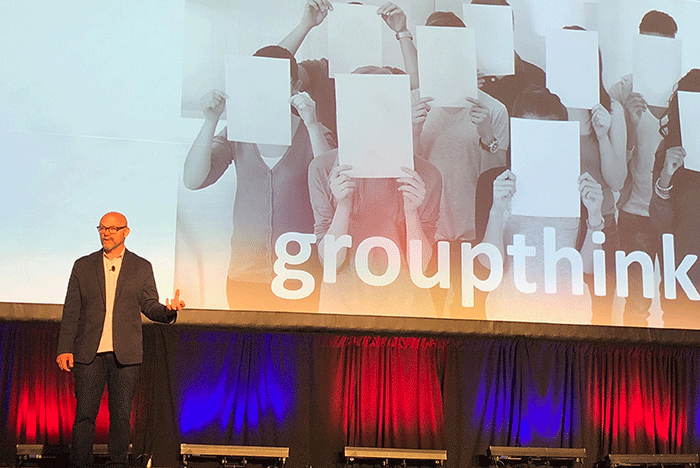Speaker highlights conflict management strategies

Joe Gerstandt discusses how to disagree well in the workplace at 2018 AHE EXCHANGE Conference.
This morning, attendees of the AHE EXCHANGE conference in Columbus, Ohio, heard from workplace expert Joe Gerstandt.
The teambuilding guru has co-authored and contributed to several books and articles regarding building relationships in the workplace. Today’s session focused on how to disagree well in the workplace with the goal of building a better decision-making process. The goal, he says, is to ensure all members of the team contribute to the process, leading to the best solutions and greater buy-in of decisions.
To make that happen, Gerstandt says leaders at the top need to embrace cognitive diversity by celebrating different thought processes and personalities. They also need to create an atmosphere of psychological safety in which employees feel encouraged to be honest and don’t feel penalized for adding to the discussion.
Gerstandt says that healthy disagreement is the foundation of a robust decision-making process, and says that “If you gather a group of human beings together you will either have disagreement or dishonesty.”
He gives four questions to help assess decision-making processes.
- Are we intentional about how we make decisions?
- Do we proactively seek out information and perspectives from different people, different places?
- Do we disagree enough?
- Do we disagree well?
Yesterday, attendees heard that environmental services departments should strive to be the secret superheroes of health care. That was part of the message at yesterday’s afternoon general session led by Rodney Rohde, PhD, MS, SV/SM/MB (ASCP) AM. Rohde is the program chair for the clinical laboratory science program at Texas State University and spoke on the globalization of infectious disease at the AHE EXCHANGE Conference in Columbus, Ohio.
During the session Rohde walked through components of the two major factors that have led to the global increase of antimicrobial resistance (AMR): microbial adaptation and human activity.
Microbes continue to mutate and adapt to resist various antibiotics and cleaning agents, which has led to multidrug-resistant organisms (MDROs). At the same time, human activity —urbanization and dense populations, global commerce and travel, the globalization of food supplies, climate change, and a breakdown in public health funding and education, etc., — has aided in the spread of AMR.
“No matter where you’re at in the world today, a microbe can hitchhike to your hospital, your school, to your football game,” Rohde says. “It doesn’t matter. Microbes know no boundaries.”
Rohde says that an increased focus on public health funding and education can go a long way as the global community fights against AMR, but he also maintains that environmental services and zeroing in on the physical environment needs to continue becoming a greater part of the plan, as well.
“It’s much cheaper and much more economical to stop an infection from happening than going on the back end trying to treat that MDRO,” he says. “Patients don’t know what [organisms are] around them. It’s our job to protect them.”
Read our recaps of other sessions you may have missed from Day 1 and Day 3 of the conference.


